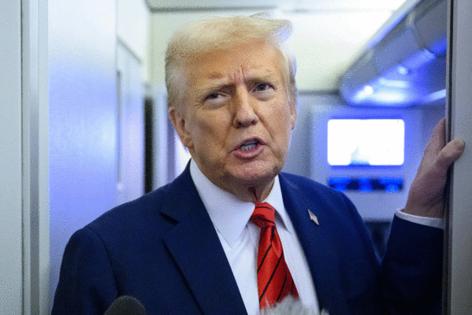Philadelphia stays on the Trump administration's new, dramatically shorter list of sanctuary jurisdictions
Published in News & Features
PHILADELPHIA — The Trump administration published a dramatically shortened list of so-called sanctuary jurisdictions on Tuesday, winnowing the number of places that the president plans to target for their refusal to help enforce federal immigration laws.
Philadelphia is still on the list.
Hundreds of other cities, counties, and states disappeared, the total number shrinking from more than 500 to a new 35.
Philadelphia’s collar counties of Montgomery, Delaware and Chester were removed. So was the state of New Jersey.
It was not immediately clear if the new list represented the specific places that Donald Trump intends to sue for what he has deemed non-compliance with federal law. Trump has repeatedly promised to withhold federal funding from these jurisdictions, which could have financial implications for Philly if that threat ever becomes a reality.
The news release from the Justice Department specifically mentioned the lawsuit it brought against New York City last month over its sanctuary policies, naming Mayor Eric Adams and other city officials as defendants.
“Sanctuary policies impede law enforcement and put American citizens at risk by design,” Attorney General Pamela Bondi said in a statement released Tuesday. “The Department of Justice will continue bringing litigation against sanctuary jurisdictions and work closely with the Department of Homeland Security to eradicate these harmful policies around the country.”
The release said the new list was not exhaustive and would be updated as federal officials gather more information. The administration is ready to help jurisdictions eliminate their sanctuary policies and be removed from the list, the Justice Department said.
Delaware was one of 12 states on the list.
It did not explain why the list had been slashed.
In June, the Trump administration removed its original list from online publication amid wide confusion over which jurisdictions were on it and how they got there.
For instance, leaders in three rural Pennsylvania counties that Trump won by more than 20 percentage points were surprised to see that their federal funding was now at risk.
Those GOP-controlled counties never held sanctuary policies surrounding immigration, a major target of the Trump administration. The only “sanctuary” policies some of them have were implemented in response to sanctuary initiatives elsewhere, intended to reaffirm their allegiances to the federal government’s rules on issues such as the right to keep and bear arms.
Homeland Security officials insist that sanctuary jurisdictions like Philadelphia protect criminal, undocumented immigrants and put law enforcement officers in peril.
Acting ICE Director Todd Lyons told WABC NY Radio, in an interview recently shared by ICE on social media, that sanctuary policies not only hurt citizens but also are “hurting that migrant community that came here for a better life, that left places where criminals preyed on them in their home countries, and now they’re having the same thing happen to them here in America.”
In Philadelphia and elsewhere, undocumented people who commit crimes are not shielded from arrest. And no local law or policy can block ICE from doing its work. Officials in sanctuary jurisdictions, also called “welcoming” communities, say they simply choose not to spend local tax dollars to help ICE.
The Justice Department did not immediately respond to questions about how it decided which places would be on the list or whether it coordinated its selections with the Department of Homeland Security, or what the potential consequences were for being included.
Philadelphia Mayor Cherelle L. Parker’s office did not immediately respond to a request for comment. Law Department spokesperson Ava Schwemler said Tuesday morning no lawsuit has been lodged by the Trump administration against the city over its policies regarding immigrants.
The city’s long-term budget plan was approved by a state board last month, despite uncertainty about potential legal actions by the Trump administration.
On the original list issued in May, Philadelphia stood among 16 Pennsylvania cities and counties named as places to be formally notified of what the president calls their noncompliance with federal immigration law. At potential risk were billions of dollars in aid that flow to hundreds of communities across the United States.
Gov. Josh Shapiro told reporters Tuesday that he had not seen the new list yet but “you never know with this administration if they get it right or not.”
In addition to Philly’s suburbs, other Pennsylvania jurisdictions, including Pittsburgh, Gettysburg, State College, and York were removed from the list since its last iteration.
Also cited at the time were Burlington County in New Jersey, Cumberland County, Camden, Trenton, and more than a dozen other Garden State localities.
The new list names only the New Jersey cities of Hoboken, Jersey City, Newark, and Paterson.
In Philadelphia, Parker has maintained that the city is not backing down from its pro-immigrant policies, including the refusal to comply with jail detainers issued by U.S. Immigration and Customs Enforcement.
ICE insists those detainers empower local jurisdictions to hold people in jail beyond the time they would normally be released. That enables ICE to travel to the jail or prison and take the person into custody.
Sanctuary jurisdictions don’t comply. They say they have no legal authority to confine someone beyond the time a judge says they should be set free — and that doing so only invites legal action. In 2020, for example, Los Angeles County paid a $14 million settlement after its sheriff’s department held more than 18,000 people on detainers.
The city of Philadelphia and Montgomery County, two prominent examples, obey ICE detainers if they are accompanied by a signed judicial warrant.
Parker has taken a noticeably different approach to the issue than her predecessor, former Mayor Jim Kenney, who championed Philadelphia’s immigrant communities and loudly antagonized Trump. The Parker administration, for instance, maintains Philadelphia is a “welcoming city,” rather than a “sanctuary” jurisdiction, though the policies are the same.
Parker’s strategy appears to have helped keep the city out of Trump’s crosshairs. But the city’s inclusion on the new Department of Justice list means the federal government is still paying attention to Philadelphia’s policies.
Last week Parker announced the appointment of Charlie Ellison as the city’s new director of the Office of Immigrant Affairs, filling a post that had been vacant since shortly after Trump took office, with the resignation of Amy Eusebio.
Immigrant advocates who have been frustrated by Parker’s conflict-averse approach were hoping she would name someone who would take the fight to Trump. Ellison appears unlikely to be that person.
Asked what tone the city should take on immigration during the Trump era, he responded, “The city is on the best possible course currently.”
At a news conference announcing Ellison’s hiring, Parker acknowledged the charged atmosphere created by the president but did not mention Trump by name.
“There is uncertainty now in the air. People don’t know what to expect from their government,” Parker said. “Your city is here to keep you safe and to safeguard your basic rights.”
------------
—Staff writer Aliya Schneider contributed reporting.
©2025 The Philadelphia Inquirer, LLC. Visit at inquirer.com. Distributed by Tribune Content Agency, LLC.







Comments